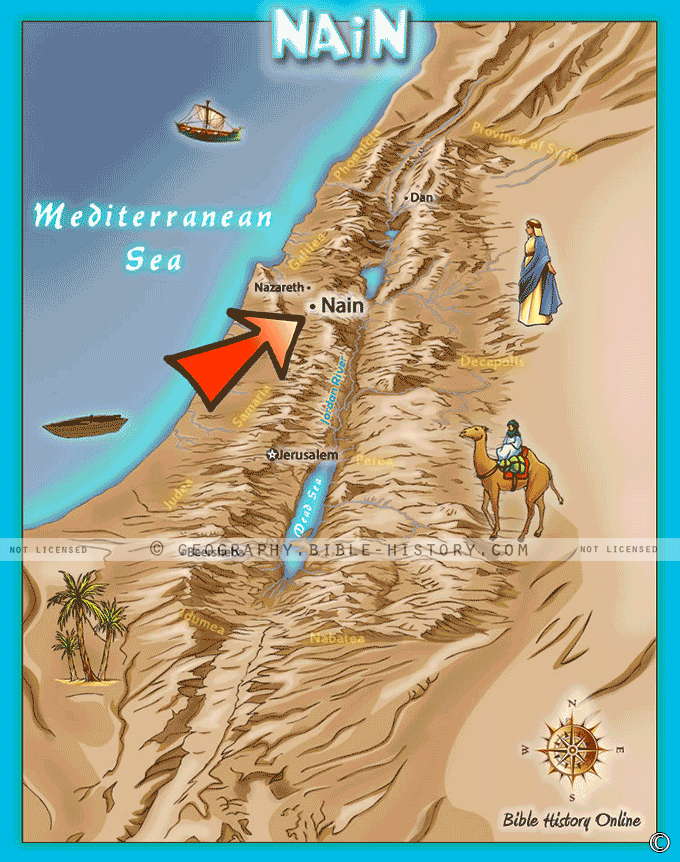
Nain, a small village nestled amidst the rolling hills of ancient Galilee, is forever etched in history due to a transformative encounter that unfolded within its modest confines. This village, though seemingly insignificant in the grand tapestry of the world, became the backdrop for a profound act of compassion and a miraculous healing, forever enshrining it in the annals of faith.
A Village of Humble Origins
Nain's very name alludes to humility, reflecting its role as a simple agricultural community where daily life revolved around labor, sustenance, and close-knit ties. Its unassuming nature conceals a narrative that would resonate far beyond its borders, illuminating the divine intervention that transcends the ordinary.
The Encounter by the Gate
The story of Nain gains prominence within the Gospel of Luke, where it's recounted that Jesus, accompanied by his disciples and a crowd of followers, approached the village gate. Here, he encountered a funeral procession, a grieving widow mourning the loss of her only son. In this heart-wrenching moment of sorrow and despair, Jesus' compassionate heart was stirred.
A Touch of Divine Compassion
Jesus' response to the widow's plight showcases his deep empathy and divine authority. Touched by the widow's grief, he approached the funeral bier and, with a simple touch and a powerful command, restored the young man to life. This miraculous resurrection filled the air with awe and wonder, igniting a chorus of praise and affirming the divine power present in Jesus' ministry.
Beyond the Physical Miracle
While the resurrection itself is a staggering display of divine authority, the story of Nain transcends the miraculous act. It's a testament to the compassion of Jesus—a compassion that recognizes and responds to human suffering, a compassion that bridges the gap between the divine and the human experience.
Legacy of Faith and Compassion
Nain's legacy extends far beyond the physical boundaries of the village. It stands as an emblem of hope for those who mourn and a symbol of the transformative power of compassion. The story reverberates with the timeless message that in the face of despair, the divine heart is moved, and in moments of grief, a touch of compassion can restore life's lost vitality.
Nain, a village whose name means "beautiful" or "pleasant," lives up to its name through the beauty of the compassion displayed and the pleasant memories of a miraculous event. The story of Nain reminds us that even in the smallest of places, the most extraordinary acts of love and healing can unfold. It invites us to embrace compassion and empathy, and to recognize that in the presence of faith and divine compassion, the seemingly impossible can become a reality.
Blank Topo Map of The World
Abraham’s Journey
The Captivity of Judah (586-516 B.C.)
The Fall of Judah 586 B.C.
The Northern Kingdom of Israel
The Southern Kingdom of Judah
The Divided Kingdom
The Fertile Crescent
Ur of the Chaldees
Shechem in Old Testament Times
Prophets, Kings, and Nations
Jesus Last Passover
New Testament Israel
New Testament Places
Old Testament Israel
Provinces of the Roman Empire
Israel during David’s Kingdom
David’s Kingdom
Cities of the New Testament 4
Cities of the New Testament 3
Cities of the New Testament 2
Mediterranean Sea
Cities of the New Testament
First Century Jerusalem
Empire of David and Solomon
David’s Kingdom
Israel Under Rehoboam
Ophir and Tarshish
The Period of the Kings
Ramoth Gilead
Samaria
Solomon’s Temple
Zarephath and MT Carmel
Jabesh Gilead and Tribes
Judah in the Time of David
Kingdom of Saul
Kirjath Jearim
Michmash
Mount Gilboa in the Time of David
Nob Davids Flight
Shiloh
Israel and Judah
Assyrian Empire Under Esarhaddon
Assyrian Empire Under Sennacherib
Captivity of 10 Tribes
Events in 2 Kings
The Khabur River
Israel and Syria
Captives From Judah
Kingdom of Jeroboam
Mesha’s Kingdom
Pharaoh Necho Battles King Josiah at Megiddo
Babylonian, Mede and Persian Empires
Samaria and Nearby Territories
Syria at its Height
Hebron
Mahanaim
1949 Map of Israel With Boundaries
First & Second Journeys of Paul
Journeys of the Apostles
Paul’s Third Missionary Journey
Saul’s Journey to Damascus and Arabia
Paul’s Final Visits
Paul’s 1st Missionary Journey
Paul’s 2nd Missionary Journey
Paul’s 3rd Missionary Journey
Paul’s Voyage to Rome
Phillip Journeys to Samaria and Gaza
Judah at the Time of Amos
Empire of Alexander the Great
Israel Under the Maccabees
Galilee During Maccabees
Idumea Intertestamental Period
Kingdom of the Ptolemies
Kingdom of the Seleucids
Ptolemaic Egypt Seleucid Asia
The Roman World
Kingdom of Ptolemies and Seleucids
The World During the 6TH Century BC
Mount Horeb
The Red Sea
The Exodus
Ezra’s Journey to Restore Jerusalem
Israel and Judah During Hosea’s Time
The Ancient World
Canaan During the Time of Abraham
The City of Shechem
Supposed Location of the Garden of Eden
The Land of Israel in Genesis
The Jordan River
The Kingdom of Nimrod
Mount Ararat and Mesopotamia
The Descendants
Sodom and Gomorrah
The Kingdom of Egypt
The Hamites
The Kingdom of the Hittites
Ur of the Chaldees
Judah at the Time of Haggai
Jesus Passes Through Samaria
